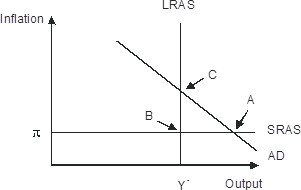If average product is falling, what is happening to short-run average variable cost?
A. If average productivity is falling, short-run average variable cost is also falling; to say that productivity falls is equivalent to saying that cost falls.
B. If average productivity is falling, short-run average variable cost could be rising or falling; it depends on what is happening with marginal productivity.
C. Short-run average variable costs are always falling. They are not related to average product.
D. If average productivity is falling, short-run average variable cost is rising; to say that productivity falls is equivalent to saying that cost rises.
Ans: D. If average productivity is falling, short-run average variable cost is rising; to say that productivity falls is equivalent to saying that cost rises.
You might also like to view...
Refer to the figure below.________ inflation will eventually move the economy pictured in the diagram from short-run equilibrium at point ________ to long-run equilibrium at point ________, 
A. Rising; B; C B. Falling; A; C C. Falling; A; B D. Rising; A; C
In the short run, there are large and persistent deviations between actual exchange rates and exchange rates predicted using purchasing power parity because of:
a. Discretionary monetary policy. b. International capital flows could cause short-term differences. c. Discretionary fiscal policy. d. Widely different inflation rates in the two nations. e. None of the above.
As the number of billboards for a firm's product increases from 100 to 500, its sales increase from $1,000 to $10,000. If this information is plotted on a line chart, the slope of the line equals ________.
The short-run supply curve for a perfectly competitive firm is
A) the industry supply curve. B) its rising portion of the average-variable-cost curve. C) its entire marginal-cost curve. D) its marginal-cost curve above the average-variable-cost curve. E) its average-revenue curve.